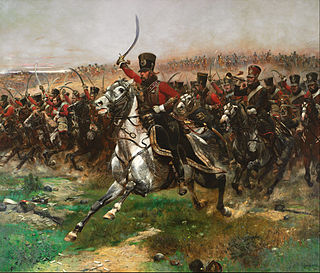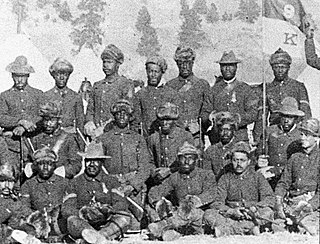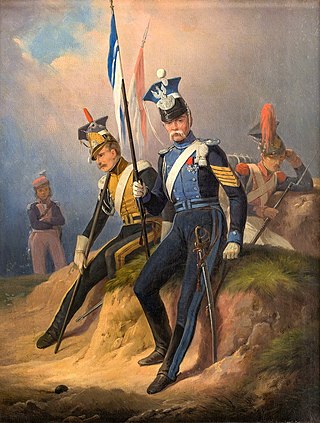
Historically, cavalry are groups of soldiers or warriors who fight mounted on horseback. Until the 20th century, cavalry were the most mobile of the combat arms, operating as light cavalry in the roles of reconnaissance, screening, and skirmishing, or as heavy cavalry for decisive economy of force and shock attacks. An individual soldier in the cavalry is known by a number of designations depending on era and tactics, such as a cavalryman, horseman, trooper, cataphract, knight, drabant, hussar, uhlan, mamluk, cuirassier, lancer, dragoon, samurai or horse archer. The designation of cavalry was not usually given to any military forces that used other animals or platforms for mounts, such as chariots, camels or elephants. Infantry who moved on horseback, but dismounted to fight on foot, were known in the early 17th to the early 18th century as dragoons, a class of mounted infantry which in most armies later evolved into standard cavalry while retaining their historic designation.

The Special Air Service (SAS) is a special forces unit of the British Army. It was founded as a regiment in 1941 by David Stirling, and in 1950 it was reconstituted as a corps. The unit specialises in a number of roles including counter-terrorism, hostage rescue, direct action and special reconnaissance. Much of the information about the SAS is highly classified, and the unit is not commented on by either the British government or the Ministry of Defence due to the secrecy and sensitivity of its operations.
Corps is a term used for several different kinds of organization. A military innovation by Napoleon I, the formation was first named as such in 1805. The size of a corps varies greatly, but two to five divisions and anywhere from 40,000 to 80,000 are the numbers stated by the US Department of Defense.

The Special Air Service Regiment, officially abbreviated SASR though commonly known as the SAS, is a special forces unit of the Australian Army. Formed in 1957 as a company, it was modelled on the British SAS with which it shares the motto, "Who Dares Wins". Expanded to a regiment in August 1964, it is based at Campbell Barracks, in Swanbourne, a suburb of Perth, Western Australia, and is a direct command unit of the Special Operations Command.

A troop is a military sub-subunit, originally a small formation of cavalry, subordinate to a squadron. In many armies a troop is the equivalent element to the infantry section or platoon. Exceptions are the US Cavalry and the King's Troop Royal Horse Artillery where a troop is a subunit comparable to an infantry company or artillery battery. Historically the remainder of the Royal Horse Artillery used the term troop in the same manner but they eventually aligned with the rest of the Royal Regiment of Artillery in referring to troops as subordinate to artillery batteries.
Sergeant major is a senior non-commissioned rank or appointment in many militaries around the world. Sergeants Major serve as the senior enlisted advisor to the commander.
Squadron leader is a senior officer rank used by some air forces, with origins from the Royal Air Force. The rank is used by air forces of many countries that have historical British influence.
In military aviation, a wing is a unit of command. In most military aviation services, a wing is a relatively large formation of planes. In Commonwealth countries a wing usually comprises three squadrons, with several wings forming a group. Each squadron will contain around 20 planes.

Uhlan is a type of light cavalry, primarily armed with a lance. The uhlans started as Lithuanian irregular cavalry, that were later also adopted by other countries during the 18th century, including Poland, France, Russia, Prussia, Saxony, and Austria-Hungary. The term "lancer" was often used interchangeably with "uhlan"; the lancer regiments later formed for the British Army were directly inspired by the uhlans of other armies.

The black beret is a colour of beret, a type of headgear. It is commonly worn by paramilitaries and militaries around the world, particularly armored forces such as the British Army's Royal Tank Regiment (RTR), the Royal Canadian Armoured Corps (RCAC), and Royal Australian Armoured Corps (RAAC) and the Indian Army Armoured Corps and Indian Border Security Force. Notable non-armored military units to wear the black beret include the non-military police and non-special forces elements of the Irish Defence Forces, MOD Guard Service, Russian Naval Infantry and Russian OMON units, the United States Air Force (USAF) Tactical Air Control Party (TACP), Philippine National Police-Special Action Force (PNP-SAF) members, and the Royal Canadian Navy. It was also worn by the United Kingdom's Royal Observer Corps (ROC) with their Royal Air Force (RAF) uniform, Metropolitan Manila Development Authority (MMDA).

Trooper from the French "troupier" is the equivalent rank to private in a regiment with a cavalry tradition in the British Army and many other Commonwealth armies, including those of Australia, Canada, South Africa and New Zealand; it is also used by the Irish Army.
The name commando has been applied to a variety of Australian special forces and light infantry units that have been formed since 1941–42. The first Australian "commando" units were formed during the Second World War, where they mainly performed reconnaissance and long-range patrol roles during Australia's campaigns in New Guinea and Borneo, although other units such as M and Z Special Units performed more clandestine roles. These units were disbanded following the end of the war; however, in the 1950s it was realised that there was a need for such units again in the Australian forces. Today, the Australian Army possesses a number of units that perform more conventional direct-action type commando roles, as well as counter-terrorism response, long-range patrolling, and clandestine deep-penetration operations.

The 171st Special Operations Aviation Squadron is an Australian Army helicopter squadron that provides aviation support to the Special Operations Command. The squadron is being equipped with the UH-60M Black Hawk helicopter. The squadron is based at Luscombe Airfield, Holsworthy Barracks, Sydney and forms part of the 6th Aviation Regiment as the regiment's sole operational squadron.

Military organization (AE) or military organisation (BE) is the structuring of the armed forces of a state so as to offer such military capability as a national defense policy may require. Formal military organization tends to use hierarchical forms.

The maroon beret in a military configuration has been an international symbol of airborne forces since the Second World War. It was first officially introduced by the British Army in 1942, at the direction of Major-General Frederick "Boy" Browning, commander of the British 1st Airborne Division. It was first worn by the Parachute Regiment in action in North Africa during November 1942.
A special missions unit (SMU), at one time referred to as a "tier 1" unit, is a designation for the United States military's most highly secretive and elite special operations forces. The term special missions unit is also used in Australia to describe the Special Air Service Regiment. Special mission units have been involved in high-profile military operations, such as the killing of Osama bin Laden and the attempted hostage rescue of Kayla Mueller.

Armoured reconnaissance also Combat reconnaissance vehicle is the combination of terrestrial reconnaissance with armoured warfare by soldiers using tanks and wheeled or tracked armoured reconnaissance vehicles. While the mission of reconnaissance is to gather intelligence about the enemy with the use of reconnaissance vehicles, armoured reconnaissance adds the ability to fight for information, and to have an effect on and to shape the enemy through the performance of traditional armoured tasks.
The 2/7th Cavalry (Commando) Regiment was one of three commando regiments raised by the Australian Army for service during World War II. It was originally raised as the 7th Division Cavalry Regiment in 1940 and in this guise it served in North Africa and the Middle East at the beginning of the war, before it was brought back to Australia and sent to New Guinea in late 1942 to serve against the Japanese. In mid-1943 the Australian high command decided to disband the divisional cavalry regiments and use their headquarters elements to administer the independent companies that had been raised earlier in the war. In the process the 7th Division Cavalry Regiment disbanded its squadrons, gave up their vehicles and changed its name to the 2/7th Cavalry (Commando) Regiment, as it became the administrative headquarters for the 2/3rd, 2/5th and 2/6th Commando Squadrons.

The 61st Cavalry Regiment is a horse-mounted cavalry regiment of the Indian Army. It is notable for being one of the largest, and also one of the last, operational non mechanised horse-mounted cavalry units in the world. Formerly deployed into active conflict, the 61st Cavalry is currently employed on ceremonial occasions, though it can be deployed for internal security or provide military aid to the civil power.

A squadron was historically a cavalry subunit, a company- or battalion-sized military formation. The term is still used to refer to modern cavalry units, and is also used by other arms and services. In some countries, including Italy, the name of the battalion-level cavalry unit translates as "Squadron Group".












